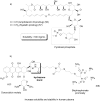The Prodrug Approach: A Successful Tool for Improving Drug Solubility
- PMID: 26729077
- PMCID: PMC6273601
- DOI: 10.3390/molecules21010042
The Prodrug Approach: A Successful Tool for Improving Drug Solubility
Abstract
Prodrug design is a widely known molecular modification strategy that aims to optimize the physicochemical and pharmacological properties of drugs to improve their solubility and pharmacokinetic features and decrease their toxicity. A lack of solubility is one of the main obstacles to drug development. This review aims to describe recent advances in the improvement of solubility via the prodrug approach. The main chemical carriers and examples of successful strategies will be discussed, highlighting the advances of this field in the last ten years.
Keywords: molecular modification; prodrug; solubility; solubility of prodrugs; water-soluble prodrugs.
Conflict of interest statement
The authors declare no conflict of interest.
Figures
































Similar articles
-
Is prodrug design an approach to increase water solubility?Int J Pharm. 2019 Sep 10;568:118498. doi: 10.1016/j.ijpharm.2019.118498. Epub 2019 Jul 10. Int J Pharm. 2019. PMID: 31301465 Review.
-
Development of water-soluble prodrugs of the HIV-1 protease inhibitor KNI-727: importance of the conversion time for higher gastrointestinal absorption of prodrugs based on spontaneous chemical cleavage.J Med Chem. 2003 Sep 11;46(19):4124-35. doi: 10.1021/jm030009m. J Med Chem. 2003. PMID: 12954064
-
Current prodrug design for drug discovery.Curr Pharm Des. 2009;15(19):2236-50. doi: 10.2174/138161209788682523. Curr Pharm Des. 2009. PMID: 19601825 Review.
-
Prodrugs - an efficient way to breach delivery and targeting barriers.Curr Top Med Chem. 2011;11(18):2265-87. doi: 10.2174/156802611797183230. Curr Top Med Chem. 2011. PMID: 21671868 Review.
-
Prodrug design to improve pharmacokinetic and drug delivery properties: challenges to the discovery scientists.Curr Med Chem. 2010;17(32):3874-908. doi: 10.2174/092986710793205426. Curr Med Chem. 2010. PMID: 20858214 Review.
Cited by
-
Analogues of Pyrimidine Nucleosides as Mycobacteria Growth Inhibitors.Microorganisms. 2022 Jun 27;10(7):1299. doi: 10.3390/microorganisms10071299. Microorganisms. 2022. PMID: 35889017 Free PMC article. Review.
-
Machine Learning Approach for Determining the Formation of β-Lactam Antibiotic Complexes with Cyclodextrins Using Multispectral Analysis.Molecules. 2019 Feb 19;24(4):743. doi: 10.3390/molecules24040743. Molecules. 2019. PMID: 30791432 Free PMC article.
-
Identification of small molecule inhibitors of the Aurora-A/TPX2 complex.Oncotarget. 2017 May 9;8(19):32117-32133. doi: 10.18632/oncotarget.16738. Oncotarget. 2017. PMID: 28389630 Free PMC article.
-
Advancement in Solubilization Approaches: A Step towards Bioavailability Enhancement of Poorly Soluble Drugs.Life (Basel). 2023 Apr 27;13(5):1099. doi: 10.3390/life13051099. Life (Basel). 2023. PMID: 37240744 Free PMC article. Review.
-
Amorphization of Drugs for Transdermal Delivery-a Recent Update.Pharmaceutics. 2022 May 3;14(5):983. doi: 10.3390/pharmaceutics14050983. Pharmaceutics. 2022. PMID: 35631568 Free PMC article. Review.
References
-
- Abu-jaish A., Jumaa S., Karaman R. Prodrug Overview. In: Karaman R., editor. Prodrugs Design: A New Era. Nova Publisher; Hauppauge, NY, USA: 2014. pp. 77–102.
Publication types
MeSH terms
Substances
LinkOut - more resources
Full Text Sources
Other Literature Sources

